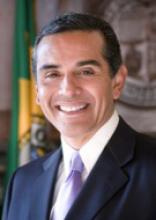
Antonio R. Villaraigosa was the 41st Mayor of Los Angeles.
Born on January 23, 1953 in the Boyle Heights neighborhood of East Los Angeles, Antonio is the oldest of four children raised by a single mother, Natalia Delgado.
Villaraigosa’s sense of civic justice and political action began at a young age. As a high school student, he volunteered with the farm workers movement, led student walkouts and organized an African-American student union.
During his junior year of high school, Villaraigosa dropped out, but eventually returned to school at the encouragement of his English teacher, Herman Katz. After graduating from Theodore Roosevelt High School, Villaraigosa attended UCLA, where he received a Bachelor’s Degree in History. He went on to attend the People’s College of Law, a night school dedicated to public-interest law.
By the age of 25, Villaraigosa was elected president of a local union representing civil rights workers and lawyers in six states. Over the next fifteen years, Villaraigosa continued this work as a union organizer for the Service Employees International Union, United Teachers Los Angeles, and then as President of the Los Angeles chapter of the American Civil Liberties Union and the American Federation of Government Employees.
In 1994, Villaraigosa was elected to the California State Assembly and, four years later, his colleagues elected him the first Assembly Speaker from Los Angeles in 25 years.
While in the Assembly, Villaraigosa spearheaded a $9.1 billion initiative to rebuild and modernize California schools, led a $2.1 billion initiative effort to provide parks and open space throughout the state, funded an extensive expansion of water quality enforcement by the state, and authored the state health insurance program, Healthy Families.
Elected as the Councilmember to Los Angeles’ 14th District in 2003, Villaraigosa was widely credited with resolving the Metropolitan Transit Authority transit strike, creating the largest passive park on the Eastside and Los Angeles, and protecting funding for the Arts.
In 2005, Villaraigosa ran for Mayor of Los Angeles on a platform of bringing the City together to take on the big challenges. He was elected on May 17, 2005 and sworn in as Mayor on July 1, 2005.
During his first term, Mayor Villaraigosa built the police force to its largest size in history, oversaw the steepest reduction in crime since the 1950’s, and developed Los Angeles’ first comprehensive anti-gang strategy.
Mayor Villaraigosa dedicated much of his first term to reforming Los Angeles’s public schools because of his passionate belief that Los Angeles will never succeed as a great global city if every child isn’t given a world-class education.
Fighting for reform from both inside and outside of the school district, the Mayor now oversees the Partnership for LA Schools, which runs ten of the lowest-performing schools. Within one year, test scores are already rising.
With the launching of GREEN LA, the Mayor set Los Angeles on the path to becoming one of the greenest big cities in the nation. The City has met the Kyoto targets for reducing greenhouse gases four years ahead of schedule; taken over 2,000 dirty diesel trucks off the road; met the first target of getting 10% of energy from renewable sources and is on track to reaching 40% by 2020; and put into place the most aggressive green building program of any large city.
Teaming up with transportation leaders throughout Los Angeles County, Mayor Villaraigosa led the effort to pass a once-in-a-generation investment in the mass transit system of Los Angeles. With the passage of Measure R, LA County is poised to invest in $40 billion in new transit, rail and highways.
On March 3, 2009, Mayor Villaraigosa was re-elected and took the oath for a second term on July 1, 2009.
Pledging to finish the work begun in his first term, Mayor Villaraigosa laid out an agenda centered on five focused goals for four years.
First and foremost of these goals, will be his effort to lead Los Angeles out of the recession and create jobs. The Mayor will also work to shut down failing schools and reconstitute them as innovation campuses, public charters or members of the Partnership Schools; set the city’s Department of Water and Power on a path to becoming coal free by 2020; oversee the largest mass transit construction program in America; and fight to keep Los Angeles one of the safest big cities in the nation by keeping the police force at 10,000 officers strong and crime at historic lows.
